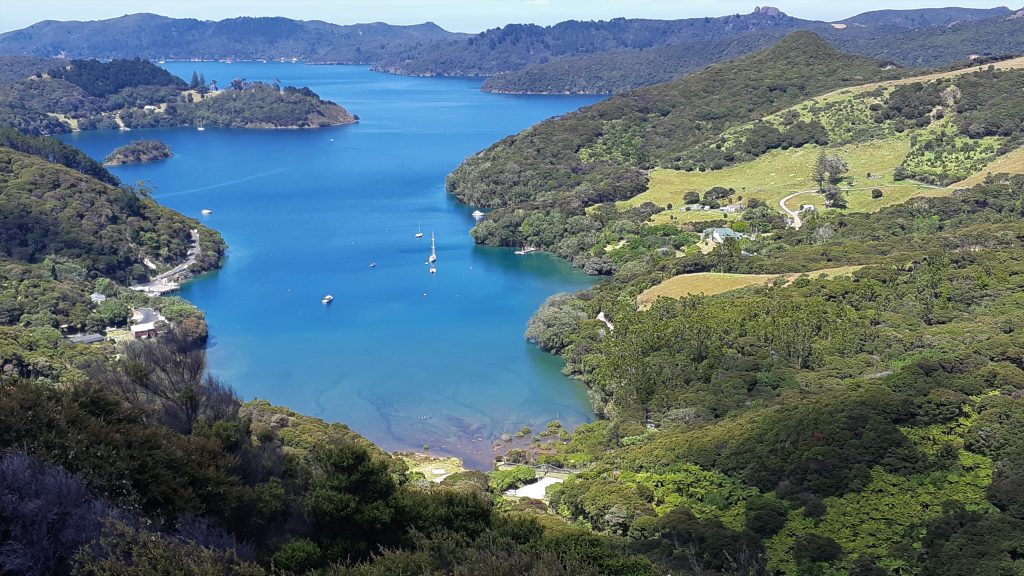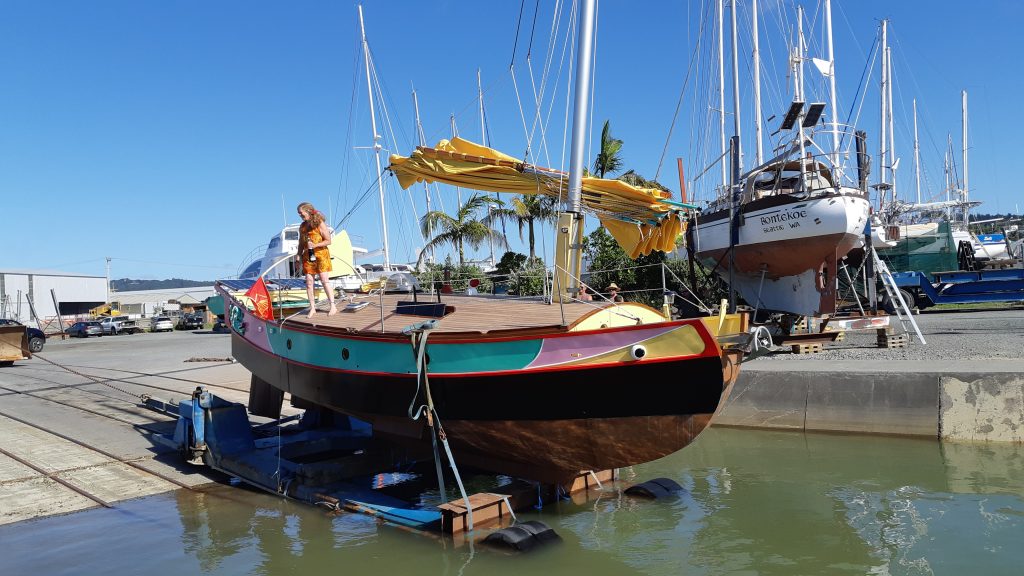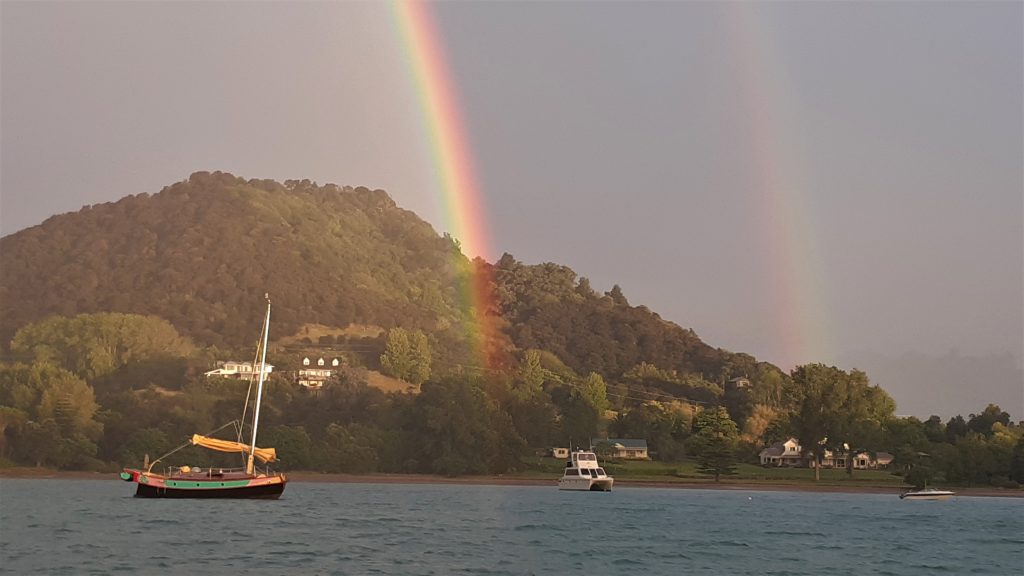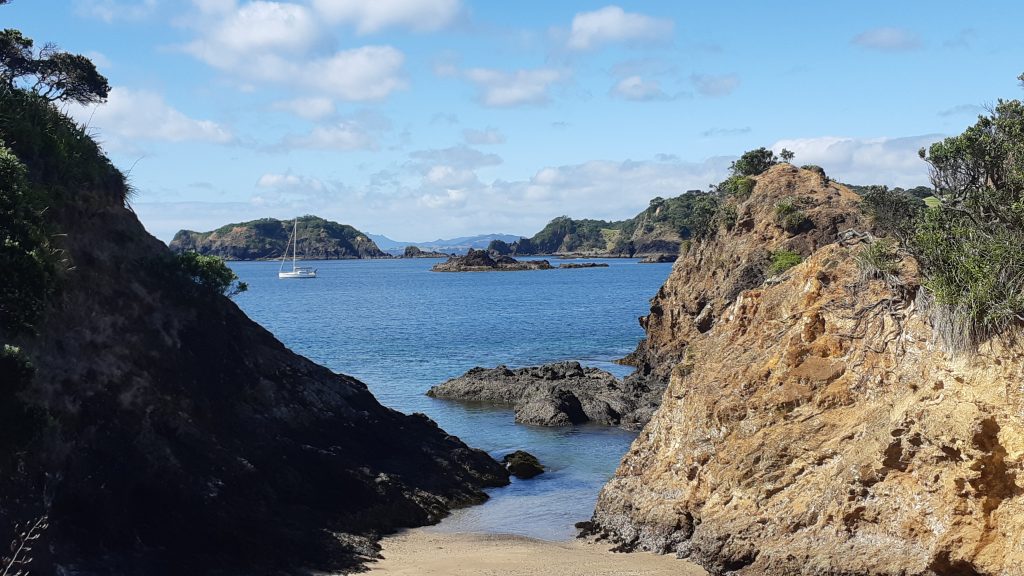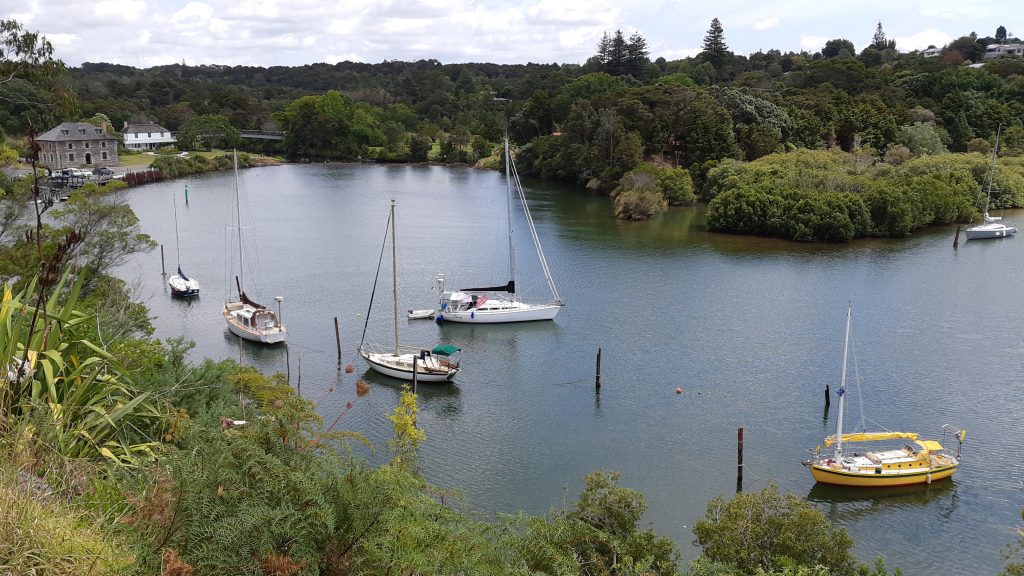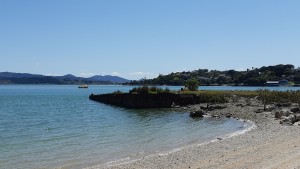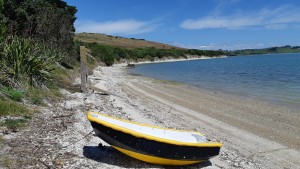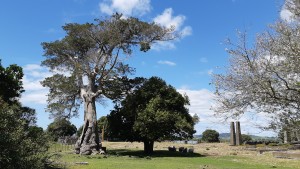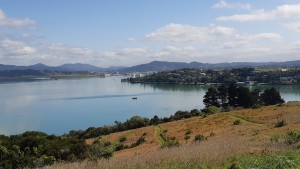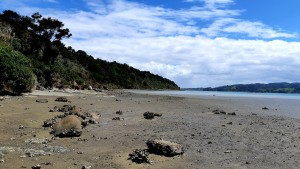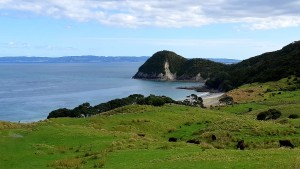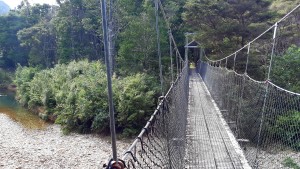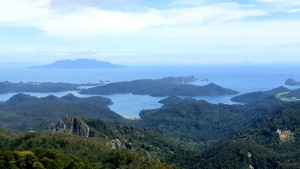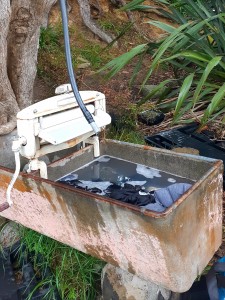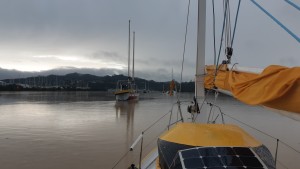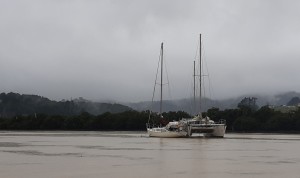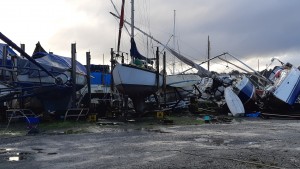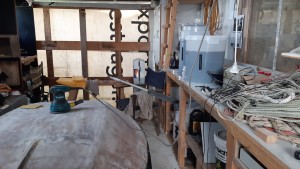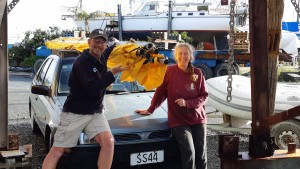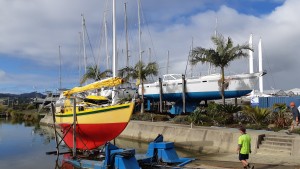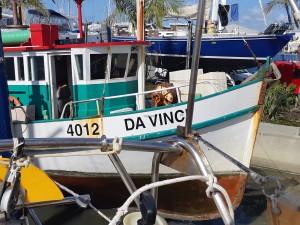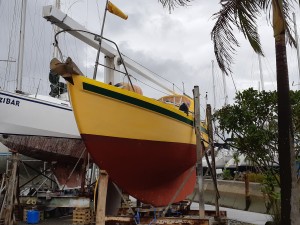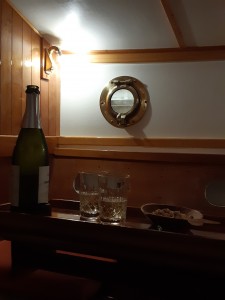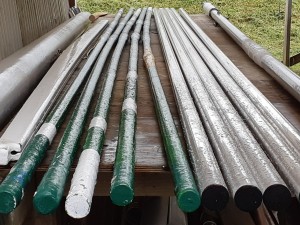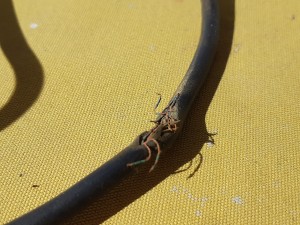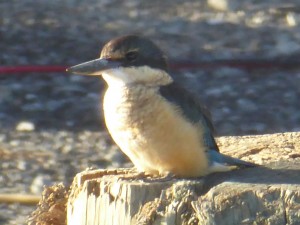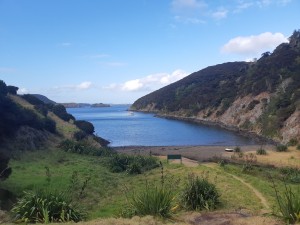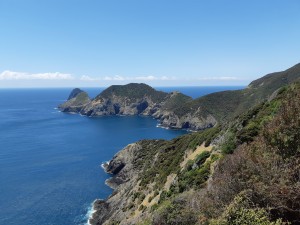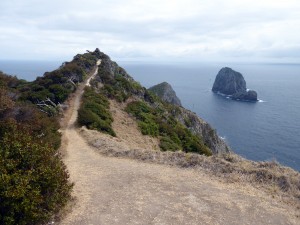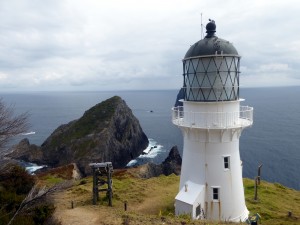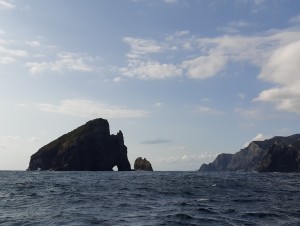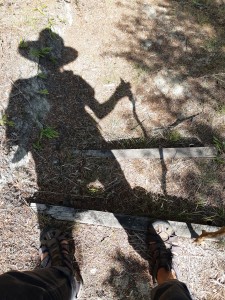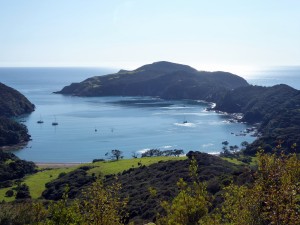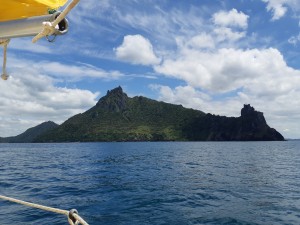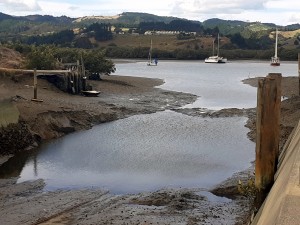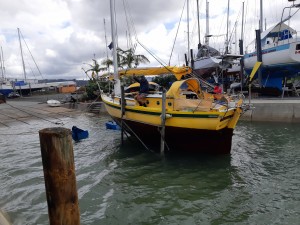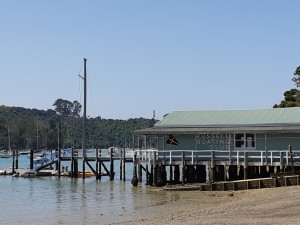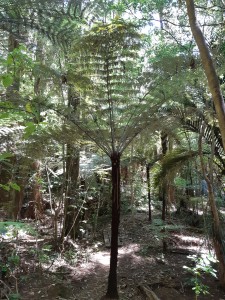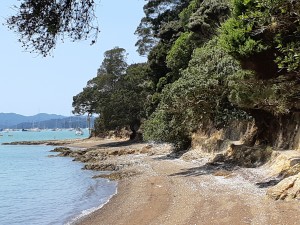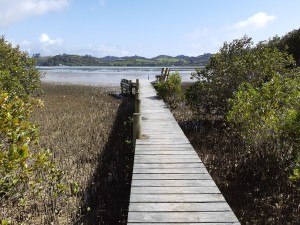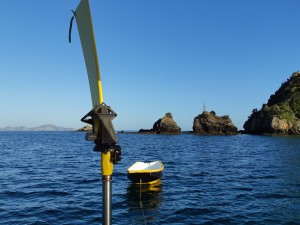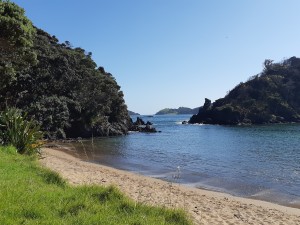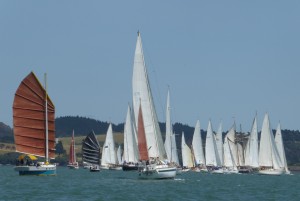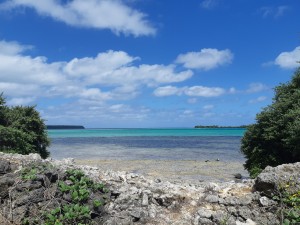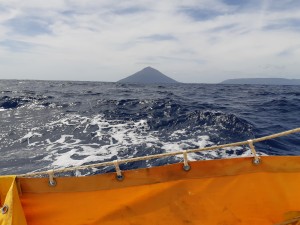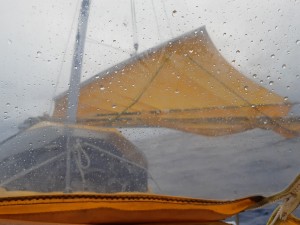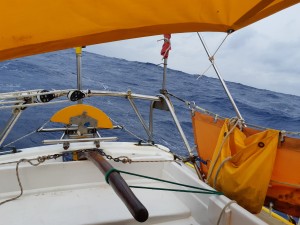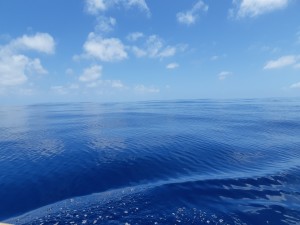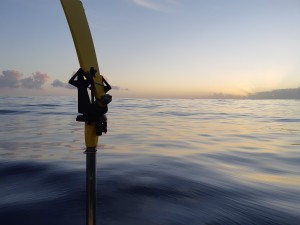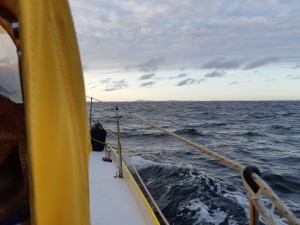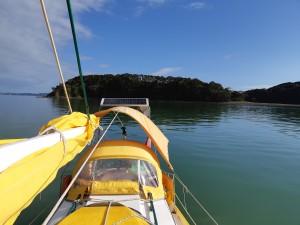Exploring the Hauraki Gulf
Sunday, November 22nd, 2020
November, 2020
My stay at Smokehouse Bay was cut short when the weekend crowds arrived and I scuttled off to find a quiet spot in Wairahi Bay just a short mile away. It is a fairly narrow and steep-sided fiord-like bay which reminded me of some of the beautiful caletas in Tierra del Fuego (with better weather).
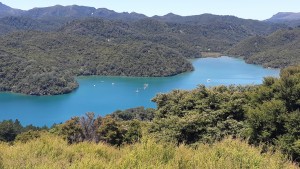
Looking down on Wairahi Bay
I stayed for a few days putting a new coat of varnish on Speedwell’s tiller, and then moved on down the coast of Great Barrier Island to Whangaparapara. As I was sailing along, a big white area on the rocky shore turned out to be a densely packed breeding ground for gannets. Many birds were flying overhead and diving on unsuspecting prey to take back to their hungry brood.
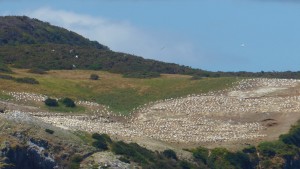
Gannet Breeding Ground
The wind was coming from the SW and I found good shelter near the entrance to Whangaparapara in Graveyard Bay. I had thought of hiking up to the hot springs but it meant a long row across the bay and the wind was really picking up. True to its name, there is a small graveyard ashore, and as darkness fell a faint light glimmered eerily from one of the graves. I reassured myself that someone must have planted one of those solar-powered garden lights there. Next day the wind turned more southerly and it was a grey drizzly day so I stayed put and settled down with a good book.
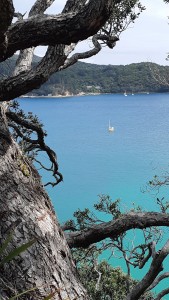
Looking down on Speedwell on the way to the grocery shop
Once again I needed to do some shopping so as soon as the weather cleared I sailed on to Tryphena where I had been told there was a grocery shop. It was a lovely little sail into a fairly open and shallow bay. I needed to anchor quite a long way off the beach at Mulberry Cove. I had become used to always being able to get internet access on my phone, but here it was very patchy. I rowed ashore and hauled my dinghy up the sandy beach, very grateful that it was sand and not mud. A local dog-walker gave me directions to the shop in the next little bay which led me along an interesting footpath following the coastline with beautiful sea views round every corner, then across the next beach to a good shop and an Irish Pub. Internet too. I restocked with as much as I could carry and headed happily back to Speedwell.
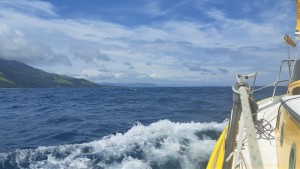
Just Sailling Along
Soon it was time to move on again, and with a favourable forecast I sailed across the gap to the Coromandel Peninsula lured on by the romantic sound of the name. My new battens looking very smart and shiny. Passing Cape Colville the water was quite turbulent but we made steady, if rather uncomfortable progress and then a fast dead downwind run along the string of large rocks and small islands leading to the entrance to Coromandel Harbour. The wind was now just E of North and I wanted to get in to Te Kouma Harbour a little further on. But then the sky darkened and we were struck with a drenching cloudburst reducing forward visibility to less than the boat length. I hastily hauled in the sail, which by now was reefed right down, and hove-to to let the squall pass. I was suddenly surprised by a noisy dive boat which had motored close up wanting to know if I was OK. I gave them an emphatic thumbs up and they roared off into the gloom. It was thoughtful of them to stop by. Soon enough the rain eased off and I was able to see where the gap in the rocks leading to Te Kouma was. Off we sailed again and after a gentle gybe were able to make the right-angled turn into the harbour and beautiful Squadron Bay.
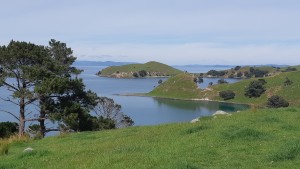
Squadron Bay
I spent a few days just relaxing and enjoying the exquisite surroundings and an easy stroll ashore up a grassy hill which gave a good view of Whanganui Island and Coromandel Harbour. Once again I waited out a weekend until most other boats had left and then moved around to a sheltered little cove on the SE coast of Whanganui. I was able to pick up a weather forecast here and it seemed like a good idea to move across to Rotoroa Island just off Waiheki which would be a fine place to shelter from the NE gale warning. Another fast downwind sail and exciting passage through a narrow gap into the shelter of Southwest Bay on Rotoroa. A sprinkling of other small boats had also decided to take refuge there and I later discovered we were four single-handers, 3 women and 1 male. Average age over 70. We all weathered the gale successfully.
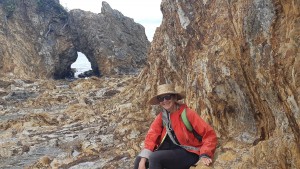
A walk on Rotoroa Island
When the wind eventually dropped I moved Speedwell a little closer to the beach and joined Helen from one of the other boats for a good walk ashore. The island is a nature reserve and a lot of work is being done to replant trees and restore the vegetation. Once again magnificent views of the maze of craggy islands and deep inlets all around. The distinctive Sky Tower marked the city of Auckland a mere 10 or so nm to the west.
On Saturday the ferry arrived bringing people to watch the release of a young kiwi. The island provides a safe predator-free refuge for the chicks at a stage when they are very vulnerable. Their survival rate in the wild being about 5%. By keeping them protected until they are more able to fend for themselves they have something like a 60% chance of making it when returned to their natural surroundings. I was thrilled to be able to watch as a young bird was removed from its protective crate and gently cradled in the arms of its keeper who then carried it around for everyone to get a good look and take photos. No touching, of course. It was quite passive and sleepy as they are nocturnal creatures. It was a wonderful and unexpected experience.
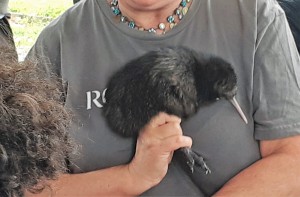
Kiwi Chick
I had hoped to spend a bit longer exploring Rotoroa but now the wind was shifting more to the west and the anchorage was very open in that direction. The other boats, being more familiar with the area suggested a move across to Omaru Bay on the east coast of Waiheki Island. It seemed like a good idea and I had a slow sail to windward to join them. By now I was running out of stuff again, my main problem being my last dwindling bar of chocolate. There is a good supermarket on the island which can be easily reached by bus from Rocky Bay on the south coast, so on I sailed to yet another beautiful spot. Unfortunately the wind was now turning more SW which made Rocky Bay a less than ideal anchorage and I did not feel that I could leave Speedwell unattended to go on a shopping expedition. We spent one night there and then sailed on heading in a clockwise direction around the island to Oneroa on the north coast. Although the wind had dropped by now, there was an uncomfortable NE swell rolling in. There were no other boats there but a Strong Wind, possible SW Gale Warning was in force and I decided to hang in there.
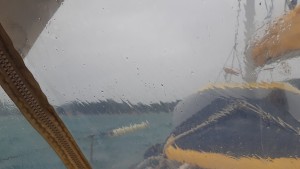
The sun wasn’t always shining
In the morning more boats started to arrive and the bay was soon quite crowded with others seeking shelter from the SW wind. And it did blow. I spent the day on board. The shopping would have to wait another day. Fortunately Helen had given me a bag containing a selection of survival rations (including chocolate) before she left and I had plenty of my very successful home brewed wine to keep my spirits up in the evening.
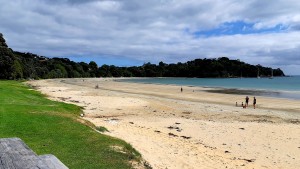
The Beach at Oneroa
When the weather finally cleared it was beautiful and I had a chance to explore the village and walk all the way across the island to the ferry dock at Matiatia. There is a choice of paths and naturally I took the less-travelled high track which proved to be very interesting as there has been a big effort at replanting trees in the area. The original kauri and other timber trees had been plundered for ship and general construction leaving the land bare. There is a lot of new growth and here and there a neat little sign has been planted next to a tree giving its name and description. I had been quite frustrated up to now trying to identify the local trees which were mostly all strange to me so this was a very welcome addition.
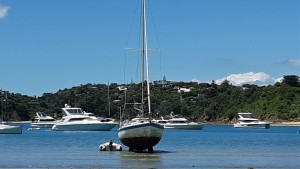
A local boat taking advantage of the tide
Over the weekend more and more boats arrived in this really lovely bay which is also conveniently close to the crowded marinas of Auckland. The weather was perfect and people were making the most of it. A swarm of little Optimist sailors were being put through their paces in the middle of the bay, the gentle wind barely enough to keep them moving. I decided to move around to Hooks Bay on the eastern coast of Waiheki to be ready for a jump back to Great Barrier when the weather was right. I motored carefully through the packed anchorage and once clear of the Optimists had a lovely gentle sail around the coast. As I was leaving the bay I spotted Oryx motoring in in the distance. The first time I had seen her at sea.
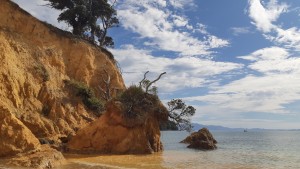
Hooks Bay with Speedwell in the distance
Hooks Bay was almost empty of boats and I found a good place to drop the anchor in 5m. I was a little disappointed when I rowed ashore the next morning to find that the Stony Batter trail had been closed since March due to Covid-19. Maybe someone had forgotten to take down the sign as all other trails appear to be open. I had a pleasant stroll along the beach and watched some dotterels, a caspian tern, red-billed gulls and some paradise shelducks pottering about at the mouth of a small stream that spilled out onto the beach.
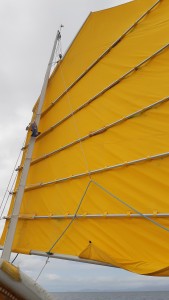
Smart new battens
On Tuesday there was a good wind for the sail back to Great Barrier Island where I hoped to find a place where I would be able to stop for a few days without having to be constantly aware of the ever-changing wind direction and forced to keep moving. All rather different to places like the Caribbean where you can depend on a pretty steady NE trade-wind for weeks on end.
I made an early start as the entrance to Port Fitzroy was 40nm away and had to be entered in daylight. A slightly slow start in SW F2-3 but by 9am we were moving nicely at 4 knots in something a bit stronger. Really, really great. As we approached the coast the wind strengthened and veered more to the west and I found myself once again on a dead downwind run into a narrow rocky inlet. Not really my favourite activity. I reefed down to 4 panels and struggled to see just where the opening was. Not easy to spot. Luckily I had a waypoint for the entrance but needed to actually see it. Of course once in the sheltered approach between a series of small islands our speed dropped right off and the wind direction became a bit confused. I prudently started the engine and with the sail sheeted tightly in, motored through the Man of War passage in a sedately safe fashion.
One reason for returning to Great Barrier was the lure of the fresh water and laundry facilities at Smokehouse Bay. Although it was only a Tuesday the anchorage was totally crammed with boats. I decided to sail on by and made my way to Wairahi Bay a little further on which was almost empty and where I’d spent a few days on my previous visit.
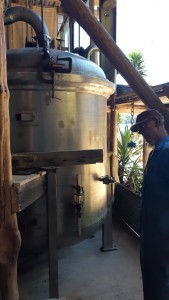
Sven and the distilling vat
A short while later Bob and Kate on Sylph VI motored over to join me. They had recently relaunched after spending many months on the hard in Whangarei doing a very extensive refit. The boat was looking immaculate and it was great to see them again. On Friday Kate and I rowed across to a little jetty across the bay which gave access to Barrier Gold where Sven has an ingenious and enormous still for extracting the precious volatile oils from Manuka and Kanuka leaves. It was noisy and I couldn’t really hear what he was saying but he gave us a detailed lecture on the process and I was happy to be able to buy a small jar of Original Kanuka Balm which is good for an enormous variety of uses.
But Bob was keen to keep moving and after a farewell dinner on Speedwell I watched them sail away on Saturday morning heading for points south.
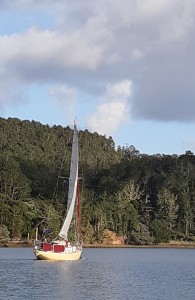
Sylph VI Heads South
I still haven’t got my laundry done, but it looks as though the crowds are thinning out at Smokehouse so maybe it will be washday on Monday.
